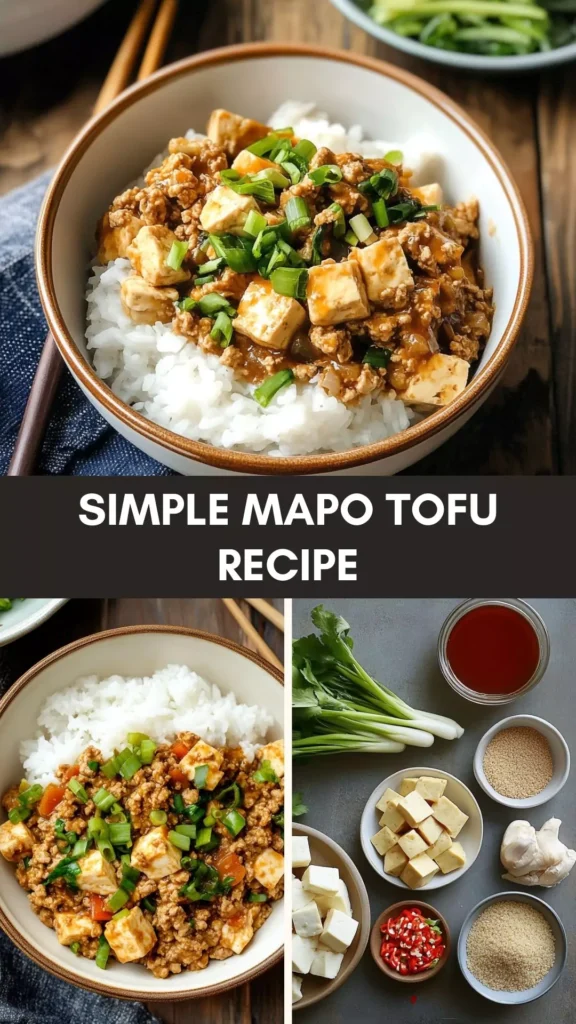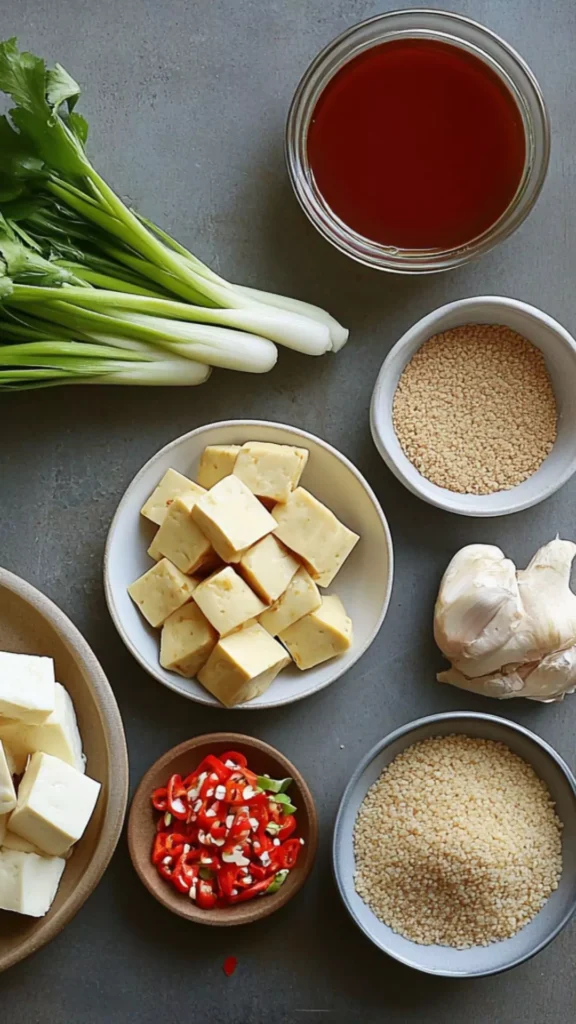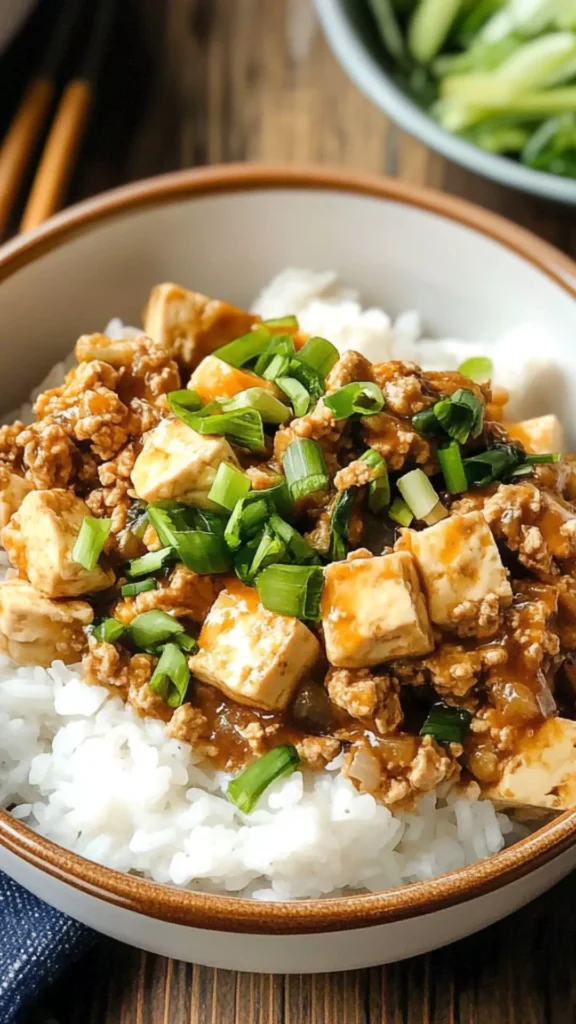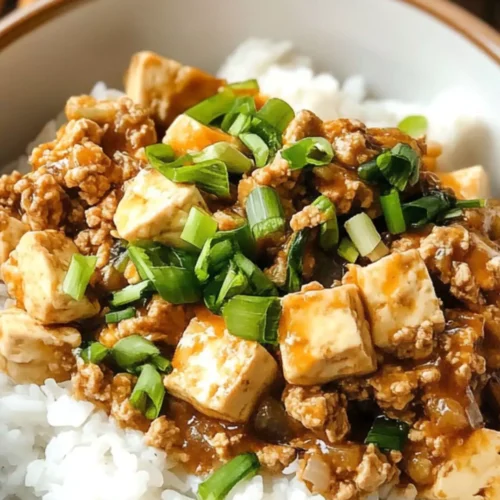Simple Mapo Tofu Recipe – Culinary Chase
Before diving into the delightful world of cooking Mapo Tofu, let’s talk about what to pair it with. A great dish deserves great company! Mapo Tofu has a rich, spicy flavor that can complement several side dishes. Here are a few fantastic ideas: Steamed Jasmine Rice, Stir-Fried Bok Choy, Chinese Cucumber Salad or Spring Rolls.

Today, I’m excited to share a dish that has earned a spot among my all-time favorites: Simple Mapo Tofu. Growing up, I first encountered this dish at a local Chinese restaurant. It was captivating!
The tofu, paired with spicy bean sauce and ground meat, created a symphony of flavors that had me hooked.
Over the years, I’ve experimented with my own version, simplifying it while keeping the comforting essence intact. Cooking is personal, and my goal is to pass along what I’ve learned.
This dish is compelling for both its taste and adaptability. Whether you’re a dedicated chef or just starting out, I guarantee you’ll enjoy it.
You will also like the following Dinner recipes!
What is Simple Mapo Tofu?
At its core, Mapo Tofu stems from China’s Sichuan province. Traditionally, it comprises silken tofu, minced pork, and a spicy bean paste that packs a punch.
What sets it apart? The balance of flavors—spicy, salty, and savory. The name “Mapo” approximately translates to “old woman’s tofu,” signifying its humble origins.
Simple Mapo Tofu embraces this tradition but streamlines the process, making it accessible for the busy home cook. With a few quality ingredients, you’ll create a plate that not only warms the soul but ignites your taste buds.
Why This Recipe Works
Let’s break down what makes this recipe a winner. First off, it’s straightforward. You don’t need to be a culinary magician to whip this up. Secondly, the ingredients are easy to source. You can find everything at your local grocery store.
The flavors meld beautifully. The richness of the pork or alternative protein, the creaminess of the tofu, and the kick from the sauce create a balance that keeps you coming back for seconds. Additionally, it’s versatile. Adjust the spice level to your liking or substitute proteins based on what you have.
Simply put, this recipe reflects my journey in the kitchen—practical, flavorful, and always satisfying.
What You’ll Need to Make This Dish
Ingredients for Mapo Tofu:
- 14 oz soft/silken tofu: This gives the dish its creamy base. Make sure to drain it well for the best texture.
- ½ lb ground pork (or your choice of protein): For a vegan option, mushrooms work as a fantastic substitute.
- 2 cloves garlic: Minced for that aromatic touch.
- 1 tablespoon ginger: Also minced. Ginger adds a warming quality.
- 2 green onions/scallions: Chopped, for garnish and flavor.
- 1 tablespoon neutral oil: For cooking the meat.
Ingredients for the Sauce:
- 2½ tablespoons doubanjiang: A spicy chili bean paste that brings the heat.
- 1 tablespoon oyster sauce: For umami richness. Use a vegetarian stir-fry sauce if needed.
- 1 tablespoon miso paste: Enhances flavor depth.
- ½ tablespoon soy sauce: Saltiness that completes the balance.
- 2 tablespoons mirin: Adds a touch of sweetness.
- 1 teaspoon toasted sesame oil: For that nutty flavor.
- 1 teaspoon potato starch: This helps thicken the sauce.
- 4 tablespoons water: To achieve the desired consistency.
For Serving (Optional):
- Japanese sansho pepper: Adds a unique peppery spice that can elevate your dish if you’re feeling adventurous.

How to Make Simple Mapo Tofu
Let’s get started on this mouthwatering adventure! You’ll find the steps simple yet effective.
Step 1: Prepare the Tofu
Start by draining the tofu. You want as much water out as possible. After that, cut it into bite-sized cubes. Set it aside to let it dry a bit more.
Step 2: Cook the Protein
In a large pan, add your oil over medium heat. Once hot, toss in the ground pork (or alternative). Sauté until it’s browned and crispy. The aim here is to get those delicious bits stuck to the pan.
Step 3: Add Aromatics
Once your protein is cooked, it’s time to introduce the flavor. Add the minced garlic and ginger to the pan. Let them cook for about 30 seconds, just long enough for that heavenly aroma to fill your kitchen.
Step 4: Whip Up the Sauce
Now, the fun begins! In a small bowl, mix the doubanjiang, oyster sauce, miso paste, soy sauce, mirin, potato starch, and water. Stir well until combined, and then pour it over the cooked meat and aromatics.
Step 5: Add the Tofu
Gently fold in the tofu cubes, taking care not to break them. Cook for a few minutes until everything is heated through.
Step 6: Final Touches
When the dish is nearly done, toss in the chopped green onions. Stir gently and taste. Adjust the seasoning if needed. If you like it spicier, sprinkle some extra doubanjiang.
Step 7: Serve Hot
Serve your Simple Mapo Tofu over steamed rice. Garnish with a dash of sansho pepper if you’re feeling adventurous.
Tips for Making the Best Mapo Tofu
- Choose the right tofu: Silken tofu yields a creamier texture. If you prefer firmer tofu, opt for medium tofu and cut it into larger cubes.
- Don’t rush the cooking: Let the meat brown well for more flavor. Patience in cooking pays off!
- Adjust the heat: If you’re cautious about spice, start with smaller amounts of doubanjiang and increase according to your comfort level.
- Garnish generously: Fresh scallions not only add a pop of color but also enhance the flavors.
- Serve immediately: Mapo Tofu is best enjoyed hot, maximizing its creaminess and richness.

How to Store Leftovers?
If you happen to have leftovers (which is rare in my house), store them in an airtight container. They can last in the fridge for up to four days.
When reheating, add a splash of water to keep the sauce from thickening too much.
How Would I Recommend Serving Simple Mapo Tofu?
Here are some delightful ways to serve Simple Mapo Tofu:
- Over Steamed Rice: The classic choice! The rice absorbs the sauce, making every bite delightful.
- In Lettuce Wraps: For a low-carb option, serve the Mapo Tofu in crisp lettuce leaves. A sprinkle of sesame seeds adds a nice touch.
- With Noodles: Toss it with your favorite noodles for a hearty twist. The tofu and sauce coat the noodles for a tasty treat.
- In a Bowl with Quinoa: For a nutritious twist, serve over quinoa. It pairs beautifully, offering an excellent source of protein.
What Alternatives Can You Use for the Ingredients if Not Available?
Sometimes, you might find yourself short on certain ingredients. Here are a few substitutes:
- Ground Pork: Ground chicken or turkey can be used for a lighter version. If you’re vegan, opt for chopped mushrooms or a mix of sautéed vegetables for a similar texture.
- Doubanjiang: If you can’t find it, Sriracha sauce mixed with miso can come close, though it won’t be as rich.
- Oyster Sauce: If this isn’t available, a combination of soy sauce and a touch of sugar can replicate that umami flavor.
- Mirin: In a pinch, white wine vinegar or even apple cider vinegar mixed with a little sugar can work as a substitute, although the taste will vary slightly.

Simple Mapo Tofu Recipe
Equipment
- Large pan
Ingredients
For the Mapo Tofu:
- 2 garlic cloves minced
- 1 tablespoon fresh ginger minced
- 2 green onions/scallions chopped
- 14 oz soft/silken tofu kinugoshi dofu; drained for 15–30 minutes
- 1 tablespoon neutral oil
- ½ lb ground pork or your choice of protein; for vegan/vegetarian, use mushrooms or other veggies
For the Sauce:
- 2½ tablespoons doubanjiang spicy chili bean paste; for less heat, use 1½ tablespoons non-spicy doubanjiang and 1 tablespoon spicy la doubanjiang; for gluten-free, use gluten-free doubanjiang
- 1 tablespoon oyster sauce substitute with Lee Kum Kee Vegetarian Stir-Fry Sauce for vegan/vegetarian or shellfish allergies
- 1 tablespoon miso paste
- ½ tablespoon soy sauce
- 2 tablespoons mirin
- 1 teaspoon toasted sesame oil
- 1 teaspoon potato starch or cornstarch
- 4 tablespoons water
For Serving:
- Japanese sansho pepper optional, for a unique peppery spice
Instructions
- Let’s get started on this mouthwatering adventure! You’ll find the steps simple yet effective.
Step 1: Prepare the Tofu
- Start by draining the tofu. You want as much water out as possible. After that, cut it into bite-sized cubes. Set it aside to let it dry a bit more.
Step 2: Cook the Protein
- In a large pan, add your oil over medium heat. Once hot, toss in the ground pork (or alternative). Sauté until it’s browned and crispy. The aim here is to get those delicious bits stuck to the pan.
Step 3: Add Aromatics
- Once your protein is cooked, it’s time to introduce the flavor. Add the minced garlic and ginger to the pan. Let them cook for about 30 seconds, just long enough for that heavenly aroma to fill your kitchen.
Step 4: Whip Up the Sauce
- Now, the fun begins! In a small bowl, mix the doubanjiang, oyster sauce, miso paste, soy sauce, mirin, potato starch, and water. Stir well until combined, and then pour it over the cooked meat and aromatics.
Step 5: Add the Tofu
- Gently fold in the tofu cubes, taking care not to break them. Cook for a few minutes until everything is heated through.
Step 6: Final Touches
- When the dish is nearly done, toss in the chopped green onions. Stir gently and taste. Adjust the seasoning if needed. If you like it spicier, sprinkle some extra doubanjiang.
Step 7: Serve Hot
- Serve your Simple Mapo Tofu over steamed rice. Garnish with a dash of sansho pepper if you’re feeling adventurous.
Notes
- Choose the right tofu: Silken tofu yields a creamier texture. If you prefer firmer tofu, opt for medium tofu and cut it into larger cubes.
- Don’t rush the cooking: Let the meat brown well for more flavor. Patience in cooking pays off!
- Adjust the heat: If you’re cautious about spice, start with smaller amounts of doubanjiang and increase according to your comfort level.
- Garnish generously: Fresh scallions not only add a pop of color but also enhance the flavors.
- Serve immediately: Mapo Tofu is best enjoyed hot, maximizing its creaminess and richness.
Nutrition
Frequently Asked Questions
1. Can Mapo Tofu be made vegan?
Absolutely! Substitute the ground pork with mushrooms or other vegetables, and use vegetarian oyster sauce or omit it altogether.
2. How spicy is Mapo Tofu?
The spice level can vary. By adjusting the amount of doubanjiang in your recipe, you can control how fiery it gets.
3. Can I freeze Mapo Tofu?
Yes, you can freeze it. However, the tofu may change texture upon thawing. I recommend eating it fresh for the best experience!
4. How can I adjust the flavor if I want it richer?
You can add additional oyster sauce or more miso paste for depth.
5. Is Mapo Tofu healthy?
Mapo Tofu can be a nutritious option, packed with protein and fiber. Using less oil and adding vegetables boosts its healthiness.
6. What if I don’t have a wok?
Not to worry! Any large skillet or frying pan works well. Just make sure it’s deep enough to hold the tofu and sauce.
Conclusion
Making Simple Mapo Tofu has been quite the journey for me. I love how it transforms from simple ingredients into a comfort food marvel. Whether you’re noshing on it for dinner or bringing it to a potluck, this dish never fails to impress.
It’s a wonderful experience to share your creation with family and friends, and I hope this guide has inspired you to try your hand at making it yourself.
Grab your ingredients, gather around the stove, and start cooking. Trust me, your taste buds will thank you! Remember, cooking should be fun. Don’t stress too much about the details. Enjoy the process, and happy cooking!
